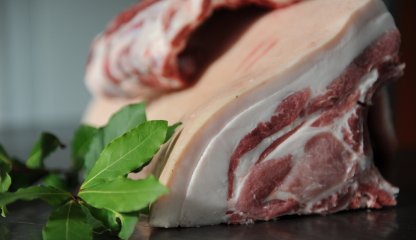PDO Cinta Senese



A unique product of historic origins
The presence of the PDO Cinta Senese breed in Tuscany has ancient origins. Evidence of this, among the most famous, is the painting "The Allegory of Good and Bad Government" (1338-40) by Ambrogio Lorenzetti, inside the Siena’s City Hall. The fresco cycle of the "Casanuova of Ama Chapel" (1596), in Gaiole in Chianti, also shows a frescoed specimen at the foot of S. Antonio Abate.
The meats, salami and fat of this animal have notably contributed to bettering the quality of life in this area of Italy; in fact, there are examples of Cinta Senese drawn in a 14th-century medical handbook: fatty deposits were probably precious not only for food but also for the preparation of unguents and creams. The breeding of this pig breed has survived, almost unscathed, multiple historical and cultural events, from the beginning of the Modern Era until the end of sharecropping and even in the immediate post-World War II period, Cinte Senesi were regularly bred.
Characteristics
The PDO Cinta Senese breed is medium sized, with black skin and a characteristic white stripe (a sort of belt, hence the name in Italian) that ties the chest to the shoulders.
The meat has excellent organoleptic qualities due in part to the special conditions of rearing and feeding. In practice, rearing consists of "grazing" the animals, which feed from what is provided by grazing in woodland and/or sown bare land; the diet then consists mainly of tubers, roots and organic material.
Cinta Senese meat boast a large amount of marbling fat, which means low liquid loss when cooked. When made into cold cuts and sausages, the products stand out for their aromas and flavours that make them a true excellence of Tuscan tradition. Cinta Senese meat is particularly savoury, tender and succulent, bright pink or red in colour.
The birthplace of the PDO Cinta Senese is the Montemaggio area, and it later spread to Chianti and throughout Tuscany. Mixed forests, especially with oaks and acorns, are the ideal habitat for this breed. The geographical area of production of PDO Cinta Senese meat is represented by the administrative territory of the Tuscany region up to an altitude of 1,200 meters above sea level.
The PDO Cinta Senese breed is medium sized, with black skin and a characteristic white stripe (a sort of belt, hence the name in Italian) that ties the chest to the shoulders.
The meat has excellent organoleptic qualities due in part to the special conditions of rearing and feeding. In practice, rearing consists of "grazing" the animals, which feed from what is provided by grazing in woodland and/or sown bare land; the diet then consists mainly of tubers, roots and organic material.
Cinta Senese meat boast a large amount of marbling fat, which means low liquid loss when cooked. When made into cold cuts and sausages, the products stand out for their aromas and flavours that make them a true excellence of Tuscan tradition. Cinta Senese meat is particularly savoury, tender and succulent, bright pink or red in colour.
The birthplace of the PDO Cinta Senese is the Montemaggio area, and it later spread to Chianti and throughout Tuscany. Mixed forests, especially with oaks and acorns, are the ideal habitat for this breed. The geographical area of production of PDO Cinta Senese meat is represented by the administrative territory of the Tuscany region up to an altitude of 1,200 meters above sea level.
Food and wine
The PDO Cinta Senese meat is appreciated in sauces and roasts, but it finds its main purpose in traditional Tuscan cold cuts such as prosciutto, capocollo, salami, rigatino and guanciale.
Information: cintasenese.org
The PDO Cinta Senese meat is appreciated in sauces and roasts, but it finds its main purpose in traditional Tuscan cold cuts such as prosciutto, capocollo, salami, rigatino and guanciale.
Information: cintasenese.org



